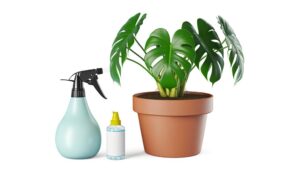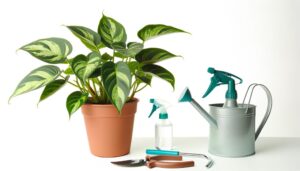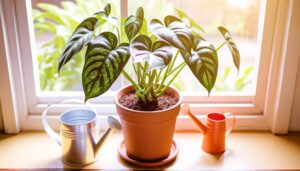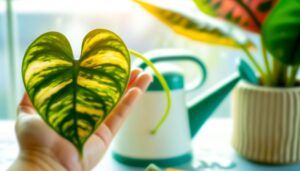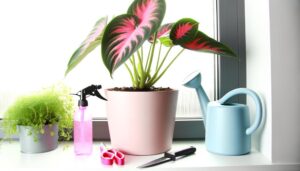How Do I Care for a Hope Philodendron Plant? Essential Tips!
Caring for your Hope Philodendron involves certain key steps. Position it for bright, indirect light, preferably by a north or east-facing window.
It’s important to water when the top inch of soil is dry, maintaining moisture without vering into waterlogging. The plant thrives in a soil mix of peat moss, perlite, and regular potting soil.
Fertilization every 4-6 weeks during the growth periods boosts overall health. Timely pruning helps maintain this plant’s appealing aesthetics.
Understanding potential pest problems and their solutions is also paramount to your philodendron’s well-being. Proceed further for a deeper exploration of these topics.
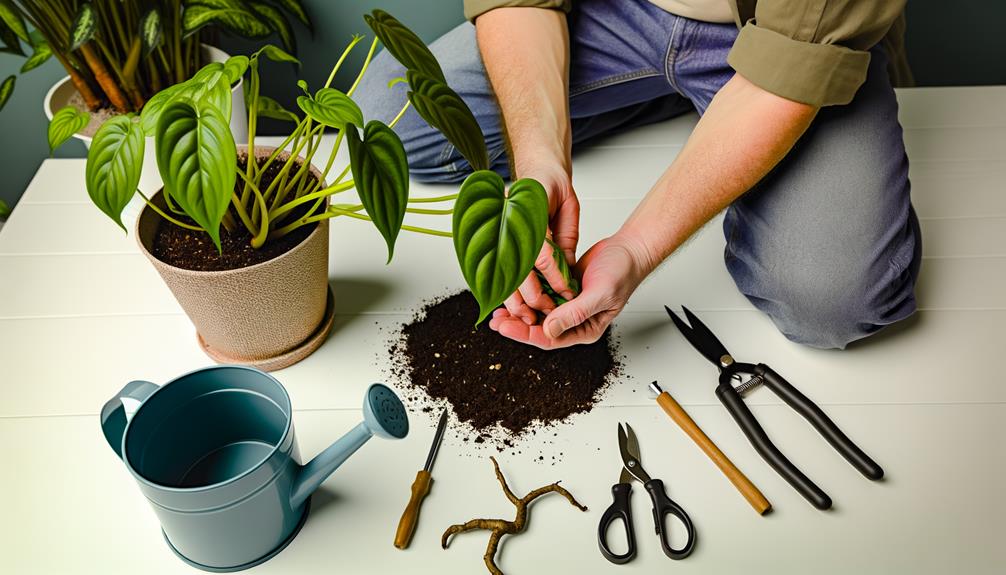
Key Takeaways
- Place your Hope Philodendron near a north or east-facing window for bright, indirect light.
- Water the plant when the top inch of soil is dry, keeping the soil moist but not waterlogged.
- Use a well-draining soil mix consisting of peat moss, perlite, and potting soil for optimal growth.
- Apply a balanced, organic fertilizer every 4-6 weeks during its active growing seasons, reducing fertilization during dormant winter months.
- Regularly check for pests like aphids and mealybugs, treating them with insecticidal soap or neem oil as necessary.
Understanding Hope Philodendron Plants
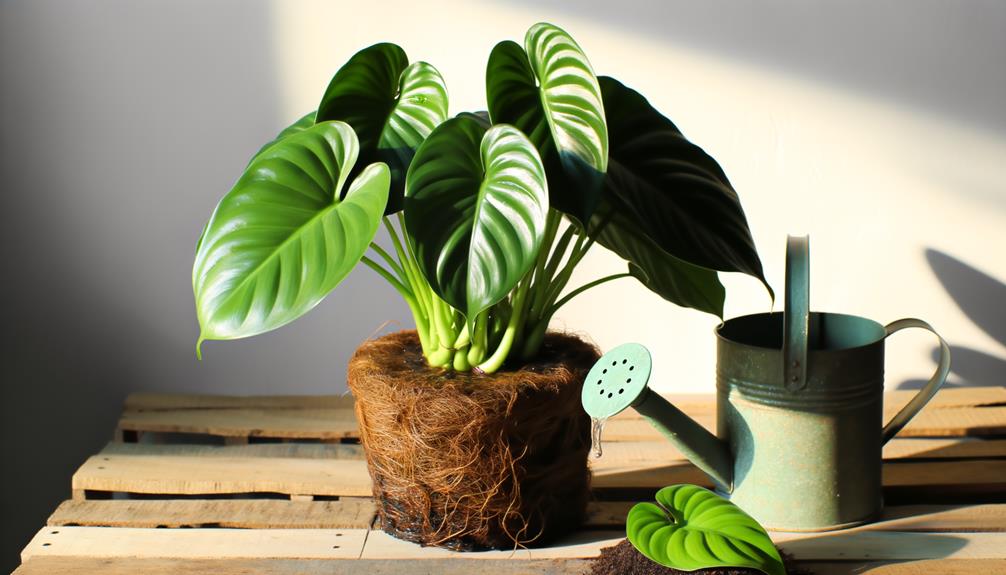
The Hope Philodendron, a popular variety of the Philodendron genus, is a tropical plant known for its large, glossy leaves and its ability to thrive in indoor environments, exhibiting a robust adaptability that has endeared it to plant enthusiasts worldwide.
Originating from South America, this plant’s lush aesthetics and low maintenance requirements make it an excellent choice for indoor gardening. It grows best in moist, well-drained soil, and its robust nature allows it to survive in a variety of temperature conditions, although it prefers a warmer climate.
The Hope Philodendron also has air-purifying qualities, which makes it not only an attractive, but also a beneficial addition to any indoor space. Understanding its unique characteristics is essential for providing ideal care.
Ideal Sunlight Conditions
In the domain of sunlight requirements, the Hope Philodendron exhibits a preference for bright, indirect light, although it showcases remarkable resilience and can adapt to lower light conditions.
However, to optimize health and growth, it is beneficial to place the plant near a north or east-facing window. The plant’s leaves can be scorched if it is exposed to direct sunlight for prolonged periods; therefore, care should be taken to avoid this.
A translucent curtain can provide a useful shield against excessive direct sunlight. In darker environments, the Hope Philodendron’s growth may slow, and its vibrant green color can fade. Hence, providing the right balance of light is crucial to maintaining the aesthetic appeal and health of this plant.
Watering Your Philodendron Hope
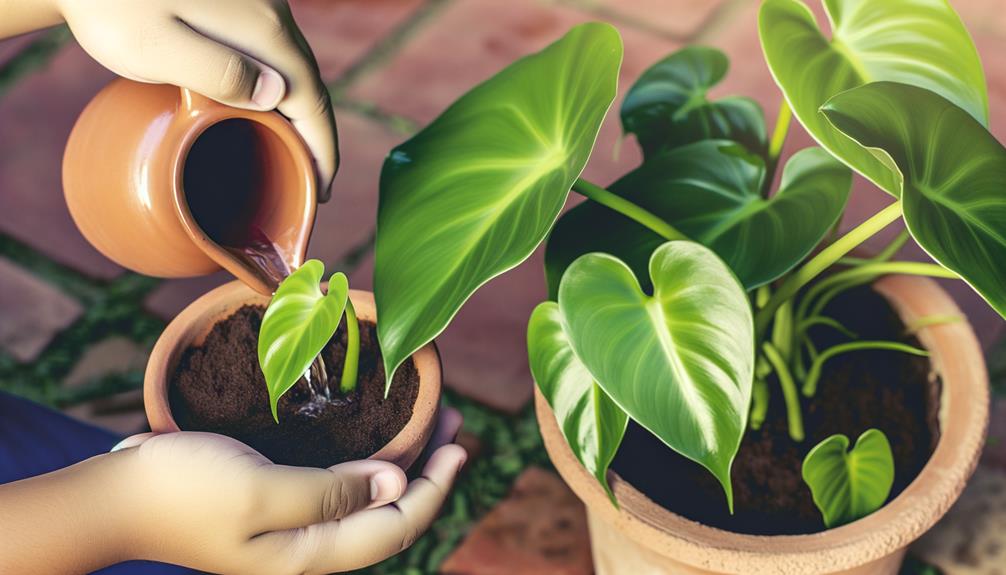
Watering your Philodendron Hope is an intricate process that demands a thorough understanding of its unique requirements.
Overwatering can lead to harmful issues such as root rot, so it’s essential to perfect the balance between sufficient hydration and over-saturation.
This discussion will explore the plant’s specific watering needs, how to prevent overwatering, and the most effective techniques to guarantee your Philodendron Hope thrives.
Understanding Watering Needs
While ideal plant health is achieved through a balance of factors, it is important to understand that the Philodendron Hope’s watering needs play a central role in its overall well-being and growth.
This tropical plant prefers a humid environment, hence it requires regular watering to thrive. However, the frequency and volume of watering are contingent on several factors such as the pot size, soil type, and indoor climate. A common rule of thumb is to water when the top inch of soil feels dry.
This typically translates to watering once a week during growing seasons (spring and summer), and less frequently during dormant periods (fall and winter). It’s crucial to provide an adequate amount of water, but remember that the aim is to keep the soil moist, not waterlogged.
Avoiding Overwatering Issues
Overwatering, a common misstep among plant owners, poses serious risks to the health and well-being of your Philodendron Hope. This issue can lead to root rot, a condition that inhibits the plant’s ability to absorb nutrients and can ultimately cause the plant to die.
To avoid this, it is essential to understand the signs of overwatering. These include yellowing leaves, a soggy potting mix, and a stagnant or foul smell.
Consider the following table to help visualize the effects of overwatering:
| Sign | Healthy Plant | Overwatered Plant |
|---|---|---|
| Leaf Color | Green | Yellow |
| Potting Mix | Moist | Soggy |
| Smell | Fresh | Stagnant / Foul |
Best Watering Techniques
Understanding the right approach to hydrating your Philodendron Hope can help mitigate the risks of overwatering. The best watering techniques take into account the plant’s native habitat, root structure, and overall health.
- Test the Soil: Before watering, always check the top inch of soil. If it’s dry, it’s time to water your plant.
- Water Deeply: Thoroughly soak the soil until water drains from the bottom. This mimics the plant’s natural rainforest environment.
- Let the Soil Dry Out: Allow the soil to dry out between watering sessions. Overly saturated soil can lead to root rot.
- Use Lukewarm Water: Avoid shocking the plant with cold water. Lukewarm water can facilitate better absorption and mitigate stress.
Choosing the Right Soil
Selecting the best soil for your Hope Philodendron plant is a critical step in promoting its healthy growth and development. This plant thrives in a well-draining soil mix that can retain some moisture without becoming waterlogged. A blend of peat moss, perlite, and potting soil, in equal parts, is often ideal.
The peat moss retains moisture and nutrients, while perlite promotes good drainage and aeration, preventing root rot. The standard potting soil provides a base with essential nutrients. It’s also beneficial to opt for a slightly acidic to neutral pH range, as this mimics the natural rainforest habitat of the Hope Philodendron.
Therefore, your choice of soil should reflect a balanced approach to moisture retention, drainage, and nutrient provision.
Fertilizing Your Hope Philodendron
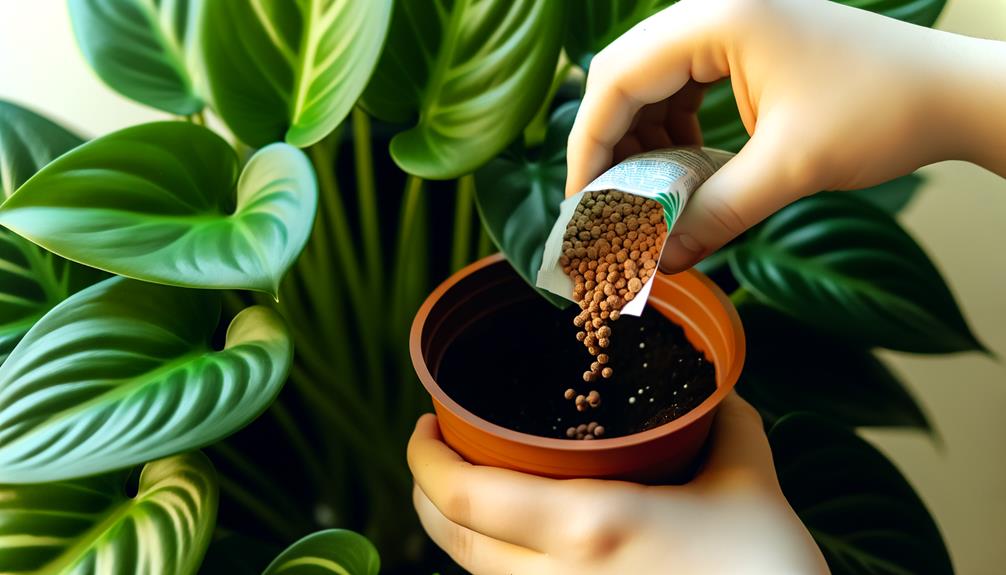
When it comes to maintaining the health and strength of your Hope Philodendron, the appropriate selection and application of fertilizer plays a crucial role.
This discussion will cover essential elements such as choosing the right fertilizer, determining the best fertilization frequency, and preventing fertilizer burn. Each of these aspects requires careful consideration, as they directly impact the plant’s growth, development, and overall well-being.
Choosing the Right Fertilizer
To ensure the robust growth and vibrant foliage of your Hope Philodendron, careful consideration must be given to the type of fertilizer used.
- Balanced Fertilizer: Opt for a balanced, water-soluble fertilizer, such as 20-20-20. This signifies equal parts Nitrogen, Phosphorus, and Potassium, important for overall plant health.
- Organic Options: Organic alternatives, like worm castings or compost, can provide a slow-release nutrient supply, promoting sustained growth.
- Low Salt Content: Avoid fertilizers with high salt content. Excessive salts can lead to root burn inhibiting growth.
- Micro-nutrient Inclusion: A fertilizer with incorporated micronutrients, such as iron and magnesium, ensures your Philodendron’s vibrant green color.
Fertilization Frequency
Given the appropriate fertilizer, the frequency of its application is essential in ensuring the best health and growth of your Hope Philodendron.
To maintain vitality, a consistent fertilizing schedule is recommended. Fertilize your plant every four to six weeks during the active growing seasons of spring and summer, ensuring a steady nutrient supply during its most vigorous growth phase.
In the dormant winter months, reduce fertilization to once every two to three months. This reduction respects the plant’s natural rhythm, preventing nutrient overload, which can cause stress.
Remember, over-fertilization is as harmful as under-fertilization. Achieving a balance is key for the best growth of your Hope Philodendron.
This thoughtful approach to fertilization frequency reflects a commitment to nurturing and serving plant life.
Avoiding Fertilizer Burn
Proper application of fertilizer is critical to prevent fertilizer burn, a common issue that can greatly affect the health and aesthetics of your Hope Philodendron. Fertilizer burn is the result of over-fertilization, causing a toxic build-up of salts that damages plant tissues, leading to leaf browning and wilting.
To avoid this, follow these detailed steps:
- Always dilute the fertilizer to half of the recommended rate. Less is more in this case.
- Apply fertilizer to damp soil, never dry. This helps distribute the nutrients evenly.
- Fertilize only during the growing season, typically spring and summer.
- Flush the soil every few months to remove excess salts.
Pruning and Repotting Tips
When it comes to maintaining the health and aesthetics of your Hope Philodendron, regular trimming and timely repotting play an essential role.
Trimming involves removing dead or yellowing leaves at the base, which promotes growth and enhances the plant’s overall appearance. Repotting, on the other hand, should be done every 2-3 years or when the plant outgrows its pot to provide it with a fresh, nutrient-rich environment.
| Trimming Tips | Frequency | Tools Needed |
|---|---|---|
| Remove dead/yellowing leaves | As needed | Clean, sharp scissors |
| Trim to shape the plant | Annually | Trimming shears |
| Disinfect tools before and after use | Always | Rubbing alcohol |
| Repotting Tips | Frequency | Materials Needed |
| Use a larger pot | Every 2-3 years | Pot, potting mix |
| Loosen root ball gently | As needed | Hands, garden fork |
| Ensure proper drainage | Always | Pot with drainage holes |
Dealing With Pests and Diseases
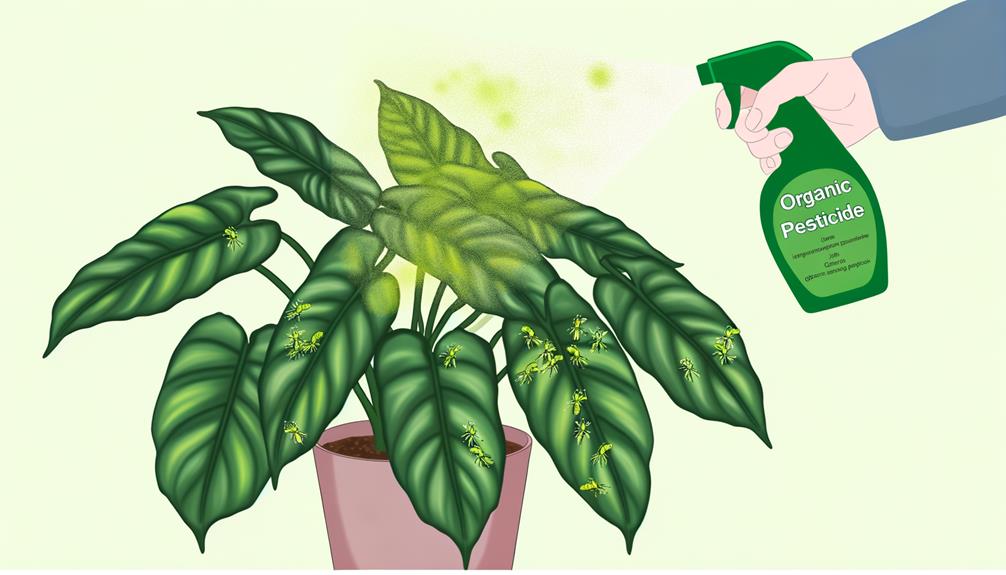
Despite thorough attention and dedication, your Hope Philodendron may occasionally fall victim to common plant pests and diseases, necessitating prompt identification and intervention to secure its continued health and essentiality.
- Aphids: These small, soft-bodied insects can cause yellowing and curling leaves. Use a mild insecticidal soap or neem oil to manage them.
- Mealybugs: Characterized by their cotton-like appearance, they can cause slow growth and leaf drop. Treat with insecticidal soap or alcohol-soaked cotton swabs.
- Root Rot: Overwatering can lead to this disease, causing wilting and yellowing leaves. Adjust watering practices and maintain proper drainage.
- Leaf Spot: Brown spots surrounded by yellow halos may indicate this fungal disease. Remove affected leaves and avoid overhead watering to prevent spread.
Faux Hope Philodendron
Faux Hope Philodendron refers to artificial or fake plants designed to mimic the appearance of the Hope Philodendron (Philodendron bipinnatifidum).
These artificial plants are made from materials like silk or plastic and are used for decorative purposes without the need for care or maintenance. They are ideal for people who want the aesthetic appeal of the plant without the commitment to regular watering, pruning, or ensuring proper light conditions.
Staking Hope Philodendron
Staking a Hope Philodendron (Philodendron bipinnatifidum) can help support its growth and keep the plant upright. Here’s how to stake it effectively:
- Choose a Stake: Use a sturdy stake that is tall enough to support the plant as it grows. Bamboo stakes or moss poles work well.
- Insert the Stake: Place the stake into the soil near the base of the plant, being careful not to damage the roots.
- Secure the Plant: Gently tie the main stem of the plant to the stake using soft plant ties or garden twine. Ensure the ties are not too tight to avoid damaging the stem.
- Adjust as Needed: As the plant grows, continue to adjust the ties and add additional support if necessary.
Staking helps keep the Hope Philodendron upright, especially as it matures and the stems become heavier.
Conclusion
To sum up, the Hope Philodendron, with its lush, tropical vibe, is a splendid addition to any indoor setting.
Though its care requires particular sunlight conditions, watering, soil type, fertilizing, and pruning, the dedication pays off with a flourishing plant.
Diligence against pests and diseases secures its long-term health.
With proper care, this plant will not only elevate the visual appeal of a space but also make a substantial difference to the overall quality of life.

